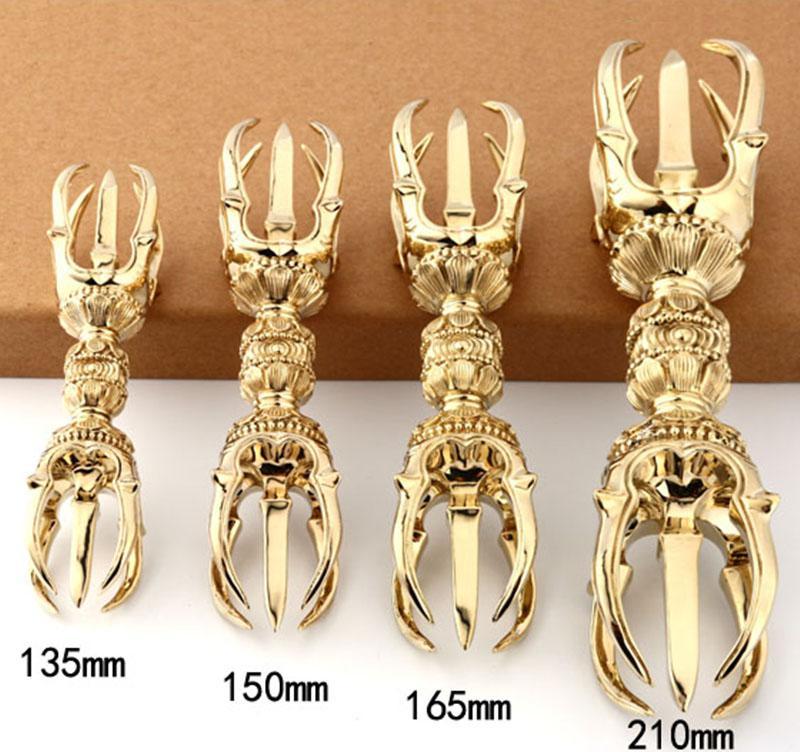Vajra pestle, known in Tibetan as "Dorji", was transliterated as Vajrayoglu, Jachira, Pajōra, etc. Also known as the treasure pestle, the descending wand, etc. Originally a weapon of ancient India. Because of its strong texture and ability to break through various substances, it is called a vajra pestle. In Buddhist tantra, the vajra pestle symbolizes the invincible wisdom and true Buddha-nature, which can cut off all kinds of defilements, destroy all kinds of demons that hinder the path, and serve as the holder of the tantric masters or the instrument of yogi monasticism.

Introduction and classification of Buddhist vajra pestles
The length of the vajra pestle varies, the length of the eight fingers, ten fingers, twelve fingers, sixteen fingers, twenty fingers are unequal, the middle is the handle, the two ends have a single strand, two strands, three strands, four strands, five strands, nine strands and other blades, the humanoid pestle karma vajra, pagoda pestle, treasure pestle, etc., and the single strand, three strands, five strands are the most common, symbolizing the single Dharma Realm, the three secrets, the five wisdom and five Buddhas, respectively.
The one-strand pestle, the three-strand pestle, the five-strand pestle, the treasure pestle, and the tower pestle are collectively called 'five kinds of pestles'. Among them, the one-handed pestle is the most ancient form, and its sharp edge is quite long, which is held by the Tantric Vajrayogini. In addition, the Vajra pestle hand in the forty hands of the Thousand Hands Kannon and one of the one hundred and eight arms of the Vajrapani Bodhisattva also hold a single pestle.
One-stock pestle
The one-stranded pestle is one of the Vajra pestles held by the Esoteric True Speakers and Practitioners. Also known as the single cobalt pestle, the single share, the single cobalt, a pestle, a strand of folding.
There are also two types of wrath shapes and ordinary shapes, and there are also shapes such as ghost eyes or ghost faces in the center of the handle, which are called "ghost eyes alone cobalt pestle" or "ghost face single cobalt pestle". When the tantric sect cultivates the great altar, the western part of the great altar, that is, the one-handed pestle, corresponds to the Lotus Huabu, representing the wonderful observation wisdom of the Vajrayogini realm Amitabha Rulai and the fetal Tibetan realm immeasurable life expectancy Rulai.
Three-strand pestle
The three-strand pestle, also known as the three-stranded Vajra, the three-stranded Vajrayogini, the three-stranded Folding Lotus, the Three-Stranded Lotus, the Three-Stranded, and so on. The three strands were originally ancient Indian weapons, and the pestle head was divided into three branches, indicating the three parts of the Buddha, Vajrapani and Lotus Hua in the fetal Tibetan realm, as well as the three tracks of the body, language, and mind, or the three wisdoms and three views of the general table.
The three-stranded pestle holders are commonly held by Manjushri Bodhisattva, Great Blissful True Bodhisattva, Vajrapani Holding VajraPani Bodhisattva, Wrath VajraPani Holding Vajra Bodhisattva, VajraPani Boy, King Sheng III Ming, Puxian Bodhisattva, Treasure Place Bodhisattva, Holding Ground Bodhisattva, Virtuous Protector Bodhisattva, and Touching Vajra Bodhisattva.
Five-strand pestle
The five strands of pestle are also known as the five wisdom vajra pestle, the five peaks of the vajra pestle, the five peaks of light, the five strands of vajra, in addition to symbolizing the five wisdoms of Rulai, the upper and lower two and five strands are combined into ten peaks, also the table ten paramitas, which can destroy ten kinds of troubles, become ten kinds of truth, witness ten places, just like the Buddha achieved the incorruptible body, language, and mind of the three honeys.
The Buddha-figure holding the five-stranded pestle is Vajrasattva. Vajrasattva Bodhisattva can bless the practitioner with a fierce heart in an instant, and attain supreme bodhichitta. It is flesh-colored, with a five-stranded pestle in its right hand leaning over its chest and a five-strand bell in its left. Holding such holdings is common among His Holiness: the Seven-Fold Buddha, Manjushri Bodhisattva (Nakadai Yabaya-in), The Great Bodhisattva, and Vajrasattva.